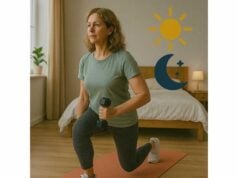
Circadian disruption is common, costly, and fixable. Whether you work rotating nights, fly across time zones, or simply drift late on weekends, misaligned sleep and light schedules strain metabolic and cardiovascular systems and erode mood and cognition over time. The aim of this guide is practical: show you how to realign more quickly, protect health when you cannot, and measure whether your approach works. We use simple levers—light and darkness, melatonin timing, meal and caffeine schedules, and brief naps—to shift the clock with less trial and error. We also suggest travel and shift-playbooks for typical scenarios and a compact tracking toolkit to see progress. If you want a broader foundation for stress and recovery habits that support resilience, visit our pillar on sleep and stress for healthy longevity.
Table of Contents
- Circadian Misalignment and Health Risks Across the Lifespan
- Light and Darkness Scheduling for Rapid Realignment
- Melatonin Timing and Dose for Phase Shifts
- Meal Timing, Caffeine, and Napping on Rotating Shifts
- Travel Playbooks: Flying East Versus West Step by Step
- Weekend Sleep Drift and Social Jet Lag Fixes
- Measuring Adaptation: Sleep Efficiency, HRV, and Mood
Circadian Misalignment and Health Risks Across the Lifespan
“Circadian misalignment” means your internal clock and your behavior are out of sync. Common examples include working nights while your body expects sleep, flying across time zones and keeping your home schedule, or sleeping later on weekends than weekdays (“social jet lag”). The central clock in the brain coordinates thousands of daily rhythms—core body temperature, blood pressure, insulin sensitivity, and hormone pulses. When timing is off, those rhythms uncouple and efficiency drops.
Short term, misalignment raises sleepiness and slows reaction time. That matters for shift workers driving home at dawn, clinicians on call, and anyone operating machinery. Over months and years, risk skews toward higher blood pressure, impaired glucose control, and weight gain. Night-shift exposure has been classified as “probably carcinogenic,” reflecting accumulating evidence connecting long, persistent night work with some cancer risks. For cardiometabolic health, even moderate, weekly misalignment (e.g., a 2–3 hour weekend shift in mid-sleep) correlates with higher body mass index and markers of metabolic syndrome in population studies. While individual susceptibility varies—genetics, chronotype, age, sex, and baseline fitness all shape risk—the direction of effect is consistent: alignment protects, misalignment strains.
Adolescents and young adults experience pronounced social jet lag due to early school or work start times and late biological preferences. The mismatch shows up as short sleep on weekdays and extended sleep on weekends, often with mood variability and daytime sleepiness. In midlife, career and caregiving layers add irregularity; alcohol and late meals compound it. Later in life, circadian amplitude weakens and light exposure often falls, making consistent routines and morning light more important.
Two implications follow. First, the clock is plastic; phase (timing) can be shifted and amplitude (strength) can be supported with routine. Light and darkness are the strongest levers, followed by melatonin timing, meal and caffeine schedules, and the timing of activity. Second, partial wins matter. Even narrowing weekday–weekend sleep timing gaps to within an hour, dimming evening light, and avoiding late caffeine can reduce symptoms within days and risk over months.
In the sections ahead, you will find playbooks for the common misalignment scenarios: how to use morning light or evening darkness to move the clock; how to dose and time melatonin when indicated; how to stack meal timing, caffeine, and short naps on rotating shifts; and how to adapt travel plans to east–west direction. Use them as templates and adjust one variable each week. The goal is not perfection; it is repeatable alignment that fits your life.
Light and Darkness Scheduling for Rapid Realignment
Light is the primary time cue for the human clock. The retina relays light, especially in the blue–cyan range around 480 nm, to the brain’s master clock. Morning light advances the clock (earlier), and late-evening light delays it (later). Darkness or very dim light removes those signals and lets your clock drift based on its own period, which for most people is slightly longer than 24 hours. Realignment is about placing strong light at the right time and cutting light at the wrong time.
For phase advances (you want to fall asleep and wake earlier):
- Morning outdoor light within 30–60 minutes of waking, 20–30 minutes on clear days or 30–45 minutes on overcast days. If you cannot go outside, sit by the brightest window you have while facing the sky.
- Avoid bright light late evening: Keep household lighting dim in the last 90 minutes before bed. Shift screen devices to darker themes and lower brightness; if work requires a screen, increase font size and contrast to reduce visual effort without raising luminance.
- Activity timing: Place exercise in the morning or early afternoon during advance days. Late-evening vigorous workouts can delay your clock.
For phase delays (you need to sleep and wake later, as in adapting to night shifts):
- Bright light during the “biological evening” before a scheduled night shift (e.g., 7–10 p.m.) using overhead room lights and task lighting; sunglasses on the commute home to block morning light.
- Create a dark sleep episode during the day: blackout shades plus a sleep mask; keep bedroom temperature cool and fans running for white noise. A 90-minute pre-sleep wind-down without screens helps your brain accept daytime as “night.”
On rotating shifts:
- Build “anchor sleep” that overlaps on all shift types—for example, always protect 04:00–08:00 as sleep on nights, and 00:00–06:00 on days, so at least 4 hours are consistent.
- Use light avoidance after night shifts: dark glasses from workplace to home; minimal sunlight exposure before you sleep.
Practical light tools:
- Timers for lamps ensure lights dim reliably.
- Sunglasses strategy: Use dark, wraparound glasses only when you actively want to avoid a strong light signal (post–night shift, early morning on eastbound trips). Do not wear them casually during the day—you need light to stay aligned.
- Workstation tweaks: Indirect lighting and task lamps close to your work surface help at night without blasting your eyes.
If you are building a household routine around light cues, pair these steps with the simple day–night anchors in our companion guide to morning light and evening darkness. Routines multiply the effect of correct timing.
Melatonin Timing and Dose for Phase Shifts
Melatonin is a hormone your brain releases at night to signal darkness. As a supplement, low doses can shift circadian phase if you take them at the right clock time. Two principles govern its effective use: precision in timing and conservative dosing.
What melatonin does in this context: It can advance or delay the clock depending on when you take it relative to your internal night. Taken in the late afternoon to early evening, it typically advances the clock (earlier sleep). Taken in the early morning, it generally delays the clock. For most readers seeking earlier sleep times, advancing is the aim.
Common phase-advance protocol (earlier schedule):
- Start with 0.5–1 mg 3–5 hours before your usual bedtime, not at bedtime. For example, if you typically fall asleep at 00:30 and want 23:00, take melatonin at ~19:30–21:30 for several days while adding bright morning light and dim evening light.
- Hold the dose for 4–7 days before adjusting. If you feel groggy or wake early, reduce to 0.3–0.5 mg or shift timing 30 minutes later.
Jet lag support:
- Eastward (you need to advance): After arrival, take 0.5–3 mg at local early evening for 2–4 nights, aiming to align with your target local bedtime rather than your home clock. Combine with strong morning local light and avoid late-night light.
- Westward (you need to delay): Melatonin is less critical. If you wake too early, a very low morning dose is not recommended—it can make you sleepy at the wrong time. Instead, use evening light and shift bedtime later for several days.
Night-shift adaptation:
- If you must flip to nights for a week or more, a small dose (0.5–3 mg) before a scheduled daytime sleep episode can improve sleep ability while you control light (dark bedroom; sunglasses on commute home). For short runs (1–2 nights), prioritize light management and naps over melatonin to avoid extended grogginess.
Dosing notes and safety:
- More is not better. Doses >5 mg offer no added phase benefit for most and increase next-day sedation.
- Consider interactions: anticoagulants, some anticonvulsants, immunosuppressants, and beta-blockers may interact or alter endogenous melatonin. Check with your clinician if you take prescription medications, are pregnant or trying to conceive, or have autoimmune disease.
- Quality varies across supplements. Choose products with third-party testing.
If you are weighing melatonin against other sleep aids, review fundamentals of timing, microdosing, and safety in our short guide to melatonin use in healthy aging. Remember: melatonin sets the clock; light drives it. Always pair the two.
Meal Timing, Caffeine, and Napping on Rotating Shifts
Food, caffeine, and naps are powerful “secondary” time cues. They do not override light, but they can nudge metabolic rhythms and determine how alert or sleepy you feel at the right times.
Meal timing and content:
- During day schedules or eastward adaptation, anchor your largest meal at local lunchtime and keep the last meal 3–4 hours before bed. Heavy, late dinners increase reflux and fragment sleep.
- On night shifts, prefer a light, protein-forward meal near the beginning of the shift and a small, carbohydrate-inclusive snack 60–90 minutes before the planned daytime sleep. This reduces hunger-related awakenings without burdening digestion.
- For rotating schedules, use “clock meals”: fixed-time meals that move with your sleep block. Even when you cannot control break timing, keep a consistent fasting window in the last 2–3 hours before your main sleep, regardless of the clock.
Caffeine strategy:
- Think dose, timing, and taper. A total daily intake ≤300 mg suits most adults; sensitive individuals may need less.
- On day schedules, place caffeine in the first 6 hours after waking, then taper. Avoid caffeine in the 8–12 hours before target sleep, especially during adaptation days.
- On night shifts, front-load caffeine in the first half of the shift and stop at least 6 hours before the planned daytime sleep. If you struggle with an early morning commute dip, a small final dose (e.g., 50–100 mg) 7–8 hours before sleep can help without wrecking daytime sleep, but test this cautiously.
For additional timing nuance, including alcohol’s effect on sleep architecture, see our practical rules for caffeine and late meals.
Napping that helps rather than hurts:
- Preventive nap before the first night shift: 90 minutes if time allows (one full sleep cycle), or a 25–30 minute power nap to reduce acute sleep pressure.
- On-shift nap: a 15–20 minute break nap in the circadian low (typically 03:00–05:00) can stabilize alertness, but set two alarms and allow 10–15 minutes to clear sleep inertia before safety-critical tasks.
- Post-shift: skip naps immediately before your main daytime sleep, which dilute sleep pressure. If unavoidable, keep it ≤20 minutes and finish ≥6 hours before the main sleep.
Hydration and electrolytes: Night environments are often dry and cool; mild dehydration worsens fatigue. Sip water regularly, especially with caffeine. If you sweat during manual work, add electrolytes without added sugar.
Red lines to avoid:
- Large, fatty meals in the final 2 hours before any main sleep.
- “Revenge caffeine” late in a shift after a bad night—it prolongs misalignment.
- Long, un-timed naps late in the “day” for night workers, which push sleep later and reduce total duration.
With practice, this trio—timed meals, caffeine front-loading, and short naps—turns chaotic shifts into predictable arcs that your body can handle.
Travel Playbooks: Flying East Versus West Step by Step
Jet lag is a phase mismatch between your internal clock and local time. The fix is strategic light, darkness, and, when helpful, melatonin. Direction and number of time zones determine the best plan.
General rules that always help:
- Sleep bank 1–2 nights before departure by adding 30–60 minutes more sleep—especially valuable before long eastbound trips.
- Hydrate and keep alcohol minimal on travel days. Alcohol worsens sleep quality and blunts clock adaptation.
- Move every hour in-flight; gentle calf pumps prevent stiffness and improve alertness on arrival.
Flying east (you need to advance your clock):
- Three days before (if possible): Move bedtime 30–60 minutes earlier each day. Get bright morning light soon after waking; reduce late-evening light.
- Travel day: If arrival is morning or midday local time, nap strategically on the plane during your home “late night,” but skip long naps if arrival is close to bedtime.
- Arrival day:
- Seek local morning light outdoors; avoid late-evening light, especially screens and overheads.
- Melatonin: consider 0.5–3 mg at local early evening for 2–4 nights, then stop once sleep is stable.
- Meals: Eat with the destination clock; keep dinner light and finish 3–4 hours before the new bedtime.
- Exercise: Easy outdoor walk + light mobility in the afternoon; skip high-intensity sessions the first day or two.
Flying west (you need to delay your clock):
- One to two days before: Shift bedtime 30–60 minutes later each day. Add evening light exposure; keep mornings moderate.
- Travel day: Stay awake on the plane if arrival is afternoon or evening local time; brief 20–30 minute naps are okay if needed.
- Arrival day:
- Evening light: maximize light exposure from late afternoon to early night to push bedtime later.
- Avoid melatonin the first couple of days unless early waking is severe. If so, take a very small dose (0.5–1 mg) at local bedtime only, then discontinue as soon as you sleep through.
- Keep breakfast later the next morning; hold caffeine until local late morning.
Short trips (≤3 time zones or ≤3 days): Consider the “don’t shift” approach: keep your home sleep and meal timing as much as possible. Use sunglasses during unwanted early light and bright light during your “biological day.”
Athletes and high-stakes events: If you must perform soon after arrival, build in 1 day per time zone for full alignment when possible. If not, prioritize light timing and short daytime naps over workout intensity. Keep heavy strength work for after adaptation.
If your schedule also requires structured training or evening electronics use, combine this playbook with the screen and lighting habits from night screen hygiene to protect early nights after eastbound flights.
Weekend Sleep Drift and Social Jet Lag Fixes
Social jet lag (SJL) is the regular difference between your weekday and weekend sleep timing. A one- to two-hour delay may feel harmless, but the Monday “hangover” reveals a clock that never catches up. Reducing SJL is the fastest, lowest-effort lever for better weekly energy.
Set an anchor wake time: Choose a 7-day wake window no wider than 60 minutes. That single change shrinks SJL even if bedtime varies. Use morning outdoor light and a consistent breakfast to lock it in.
Use a “plus–minus” bedtime: Give yourself a ±45-minute bedtime range around a target. If you go to bed late on Saturday, set two alarms Sunday: one to wake up close to your anchor time, one for a 20-minute afternoon catch-up nap if needed.
Plan social evenings with intent:
- Front-load social time: meet earlier, move heavy dinners to earlier hours, and walk after meals.
- Alcohol awareness: cap intake and finish at least 3 hours before sleep; hydrate and space drinks with water. Alcohol fragments sleep and reduces deep sleep, compounding SJL.
Sunday reset protocol (if you drifted late):
- Wake within 60 minutes of your anchor time.
- Immediate outdoor light for 20–30 minutes.
- Exercise: short, moderate-intensity session late morning.
- No caffeine after early afternoon.
- Early dinner and dim lights 90 minutes before bed.
- Optional: 0.3–0.5 mg melatonin 4–5 hours before target bedtime for one night only.
Teen households: Teens have later biological clocks and early school times. Protect regular wake times, add morning light (bus stop light counts), and consider earlier weekend activities to avoid a >2-hour shift. If devices are a driver of late nights, enable night modes and build a house rule for device parking 60–90 minutes before bed. For room setup, see our concise guide to sleep hygiene basics.
When late nights are non-negotiable: If your profession or social life requires occasional very late evenings, treat them like “mini westbound trips”: push the next day’s light later (midday), avoid early bright light, and resume anchors the following morning. It is better to take one corrective day than to let SJL persist all week.
The aim is stability with flexibility. Shrink SJL most of the time, handle exceptions with a plan, and you will feel the difference by the next workweek.
Measuring Adaptation: Sleep Efficiency, HRV, and Mood
You do not need a lab to know whether your strategy works, but you do need to track a few signals and keep notes when you change something. The best metrics are simple, repeatable, and sensitive to misalignment.
Sleep efficiency and timing:
- Sleep efficiency is the percentage of time in bed spent asleep. Aim for ≥85% most nights. If you are in bed for 7.5 hours and sleep 6.5, efficiency is ~87%. On new shifts or after flights, expect a temporary drop; it should recover within 3–5 days if your protocol is working.
- Sleep latency (minutes to fall asleep) reveals evening light and caffeine effects. Latency >30 minutes repeatedly suggests your evening light is too bright, your caffeine is too late, or your bedtime is mismatched with your current phase.
- Mid-sleep time (MST) pinpoints your clock. Track the midpoint between sleep onset and wake. To reduce social jet lag, aim to keep weekday and weekend MST within 1 hour.
HRV and resting heart rate (RHR):
- RHR often runs 3–8 bpm higher during severe misalignment. Watch for a downward trend as you realign.
- HRV (e.g., RMSSD) varies person to person. Use your baseline window, not population averages. After eastbound travel, HRV may dip for 2–3 days; it should rebound as sleep consolidates. Night-shift transitions often show a sawtooth pattern—volatile on switch days, steadier when anchor sleep is protected.
Alertness and mood:
- A simple 1–5 morning alertness score and a 1–5 evening mood score capture what matters most. If both improve as sleep efficiency rises, you are on track. If they diverge (e.g., good efficiency but low mood), examine light exposure and social jet lag rather than pushing more sleep time.
Run structured experiments:
- Change one lever (e.g., add 20 minutes of morning outdoor light).
- Hold for 7 days.
- Log: bedtime, wake time, light exposure (yes/no morning/evening), caffeine cutoff, melatonin timing/dose, exercise timing.
- Decide: keep, modify, or discard based on sleep efficiency, RHR/HRV trend, and how you feel.
When to seek help: Persistent insomnia (trouble falling or staying asleep ≥3 nights/week for ≥3 months), loud snoring with pauses, or severe daytime sleepiness require clinical assessment. Cognitive behavioral therapy for insomnia is first-line for chronic insomnia and pairs well with circadian strategies.
When devices flood you with numbers, refocus on the few that predict better days. For a deeper dive on choosing and interpreting wearable metrics in midlife and beyond, see our overview on what to track and what to ignore.
References
- Circadian disruption and human health (2021) (Review)
- Interventions to Minimize Jet Lag After Westward and Eastward Flight (2019) (Systematic Review)
- Melatonin for the prevention and treatment of jet lag (2002) (Systematic Review)
- IARC 2019: “Night shift work” is probably carcinogenic (2019) (Commentary/Position)
- A systematic review and meta-analysis on light therapy for shift workers (2025) (Systematic Review)
Disclaimer
This article provides general education on circadian strategies and is not a substitute for personalized medical advice, diagnosis, or treatment. Seek guidance from a qualified clinician if you have chronic insomnia, suspected sleep apnea, cardiovascular or metabolic disease, are pregnant, take prescription medications that affect sleep or circadian timing, or plan major schedule changes. If you experience excessive sleepiness, dizziness, or safety risks at work or while driving, stop and rest, and obtain professional care.
If this guide helped you, please consider sharing it on Facebook, X (formerly Twitter), or your preferred platform, and follow us for future updates. Your support helps us continue creating practical, high-quality resources.










